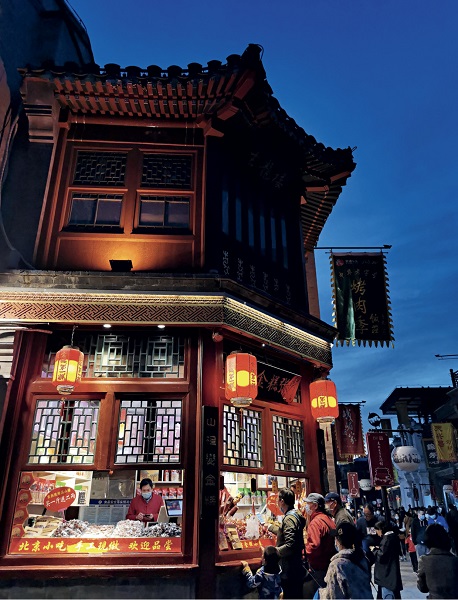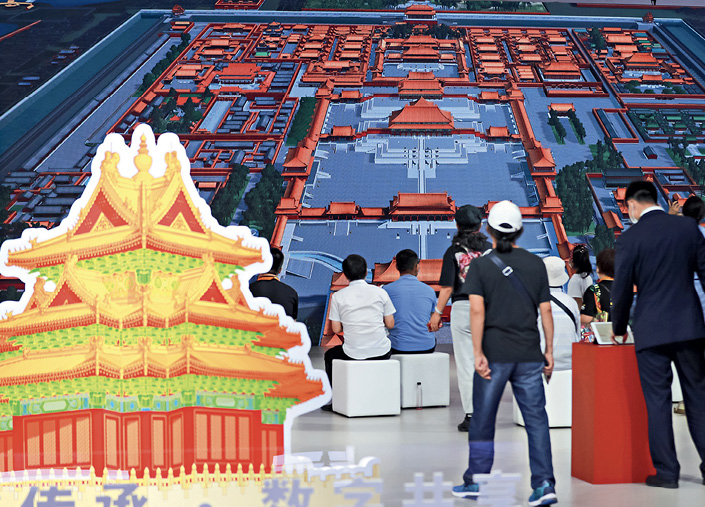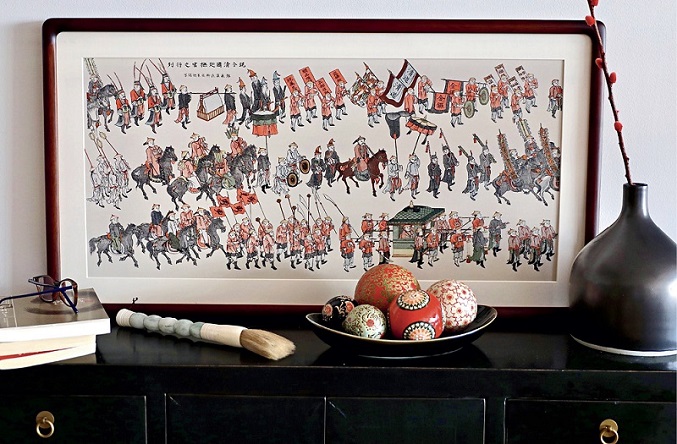The Central Axis of Beijing and Chinese Wisdom

Tourists are wandering around Xianyukou Street, near Qianmen Street on April 3, 2021.
When pioneering journalist Eliza Scidmore, National Geographic’s first official female writer, photographer, and board member, visited Beijing in 1899, she wrote a 20-page rapturous article about the city’s architecture. What I found curious was its absence throughout of the term “Central Axis.”
It was in 1996 that I first arrived in Beijing from Denmark and discovered a stark difference in what Scidmore and I found most striking about the Beijing cityscape.
At that time I had no idea what the Central Axis was. But in retrospect, it was along this 7.8 km-long urban artery that I discovered Beijing’s architectural essence. It was the Central Axis of Beijing that first led me to the Forbidden City and Jingshan Park. But Scidmore was less fortunate, because during the Qing Dynasty access to these imperial sites was impossible, while the imperial city’s buildings were off-limits to the outside world. Over the past 20 years, Beijing has continued to evolve, its most significant added feature being the layer upon layer of ring roads that have been constructed to keep pace with the Chinese capital’s steady expansion.

Audiences are watching the Digital Palace Museum through a big screen at the National Convention Center in Beijing, on September 5, 2021.
The history of Beijing has always fascinated me. I discovered early on the link between past and present that the Central Axis constitutes, and how, like the city itself, it continues to evolve and change.
The city that Scidmore visited in 1899 was like a maze – a huge architectural complex of connected and enclosing walls. That her article made no mention of the Central Axis is probably because she never actually beheld it. This is only possible from Wanchun Pavilion at the summit of Jingshan Park.
Anyone familiar with the Central Axis of Beijing will know that it starts from Yongdingmen (or Yongding Gate) in the south and extends towards the Drum Tower and Bell Tower. It is in effect a backbone connecting the Outer City with the downtown area and the Imperial City and Inner City districts. It is also the site of many landmark buildings. The term “Central Axis” came to prominence in the years preceding the 2008 Olympics. It was then that I learned how, in the 1950s, Yongdingmen at the southern end of the axis had been demolished to facilitate traffic. It was the upcoming Olympics and desire to reflect Beijing’s original urban layout that prompted the authorities’ decision to rebuild Yongdingmen. Chinese and foreign experts agreed that as the Olympic Park, site of more than half of the Olympic venues, was located at the northern end of the extended Central Axis, and rebuilding Yongding Gate was necessary in order to balance and hence render it complete.
Another reason why Eliza Scidmore made no mention of the Central Axis was that it went by another name during the Ming and Qing Dynasties. In the True Accounts of the Qing Dynasty, a compilation of official Qing Dynasty chronicles, the expression “Imperial Road” designates what we know today as the Central Axis of Beijing.
Some say that the celebrated architect Liang Sicheng, who studied urban planning in Beijing as a youth, used the term “Central Axis” in reference to Beijing’s backbone. The Central Axis was hence inextricable from urban planning. But I discovered that it is not the urban planning alone that has a central axis, as the layout of almost every siheyuan (quadrangular courtyard dwellings) in the old city is structured according to this principle. In clearly defining the north-south orientation of these dwellings, therefore, there is nothing unique about it. Houses at that time were built to facilitate both ventilation and gauging the time of day according to the position of the sun.
After the fall of the Qing Dynasty, Beijing’s ancient city walls and gates were steadily demolished. The city gates, originally connected by an enclosure for defense outside them or barbican (wengcheng), and the city walls soon became isolated structures. Rapid urban modernization during this period rendered these ancient buildings, as occurred in Western countries, nothing more than emblematic landmarks. The Qianmen Gate exemplifies the trend.


The furnishings in Lars Ulrik Thom’s home show his affection for Beijing's history and traditional culture.
Early in the 20th century the newly built Beijing Railway Station stood beside the fortified walls of Qianmen, which consisted of the Gate Tower, the Archery Tower, and the Barbican between them. To cope with the influx of passengers, the Beijing municipal government decided to demolish the Gate Tower and the barbican, leaving the Qianmen Archery Tower as the sole one of the three still standing. German architect Curt Rothkegel, designer of many iconic buildings, masterminded these renovations. Much like the Eiffel Tower in Paris, Rothkegel’s remodeled Archery Tower embodied the city’s modernization at the time, and was often the backdrop for publicity stunts. Although its iconic status has long since faded, Daqianmen cigarettes, a brand popular in the 1930s-1940s, remain on sale everywhere.
There are many theories regarding the origins of the Central Axis of Beijing. As a foreigner, I am not qualified to say which is right or wrong, but my favorite one is in the Chronicles of Capital City Dadu in the Yuan Dynasty (Xijinzhi Jiyi). The author, Xiong Mengxiang, states that upon founding the Yuan Dynasty, Kublai Khan wanted the architect, Liu Bingzhong, to confirm that his dynasty had indeed been established along a central axis facing the north. Liu Bingzhong, pointed to a tree standing outside today’s Tian'anmen and told the Emperor, “This tree was my guide.” Chinese ancients would often use the shadow cast by a tree or a pillar as a reference whereby all shadows at noon point north.
If we imagine the city of Beijing as a square, like the Chinese character 口 (kou, meaning mouth) and add the central axis at its center, we get the character 中 (zhong, meaning center). The Central Axis of Beijing so symbolizes the ancient capital and the world’s longest urban central axis that bisects it. According to modern calculations, the Central Axis of Beijing as delineated by Kublai Khan coincided more or less with the meridian line, which was off-center by only 200 meters, west of the Di’an Gate.
This, however, was intentional, because 270 kilometers or farther north stood Shangdu – Kublai Khan’s ancient capital. Chinese Fengshui (an ancient Chinese traditional practice which claims to use energy forces to harmonize individuals with their surrounding environment) held that building the capital and palace on the veins of the dragon that was believed to lie beneath Beijing would ensure a stable society and guarantee good harvests for all time. Most of the important imperial buildings were positioned symmetrically to the east and west. The main reason why Kublai Khan established his capital in Beijing was its central location, which avoided containment by the north while enabling him to control the south. That’s why it’s such an excellent choice for modern visitors! 
blog comments powered by